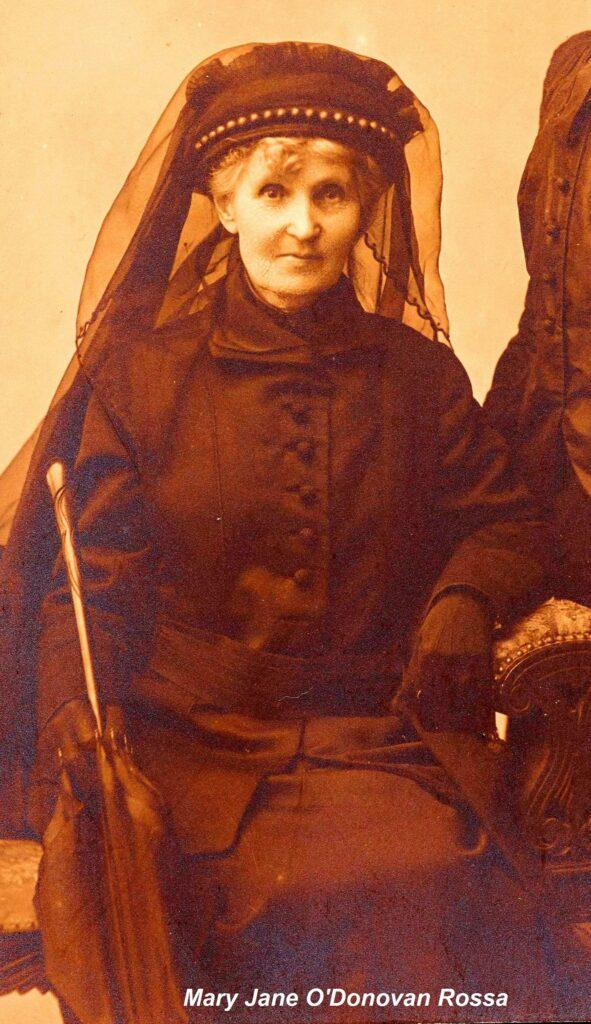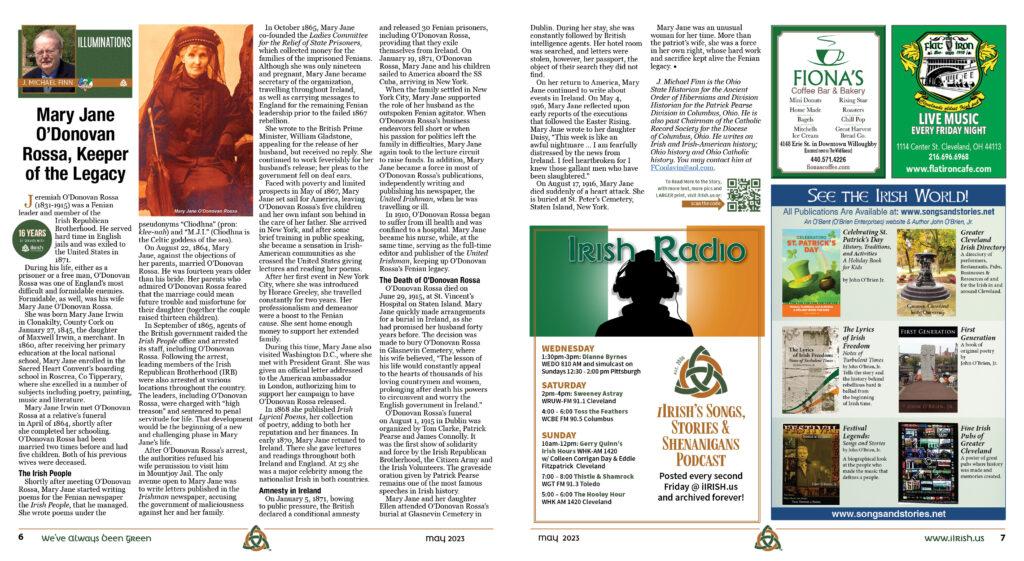

Illuminations: Mary Jane O’Donovan Rossa, Keeper of the Legacy
By J. Michael Finn
*
Jeremiah O’Donovan Rossa (1831-1915) was a Fenian leader and member of the Irish Republican Brotherhood. He served hard time in English jails and was exiled to the United States in 1871.
During his life, either as a prisoner or a free man, O’Donovan Rossa was one of England’s most difficult and formidable enemies. Formidable, as well, was his wife Mary Jane O’Donovan Rossa.
She was born Mary Jane Irwin in Clonakilty, County Cork on January 27, 1845, the daughter of Maxwell Irwin, a merchant. In 1860, after receiving her primary education at the local national school, Mary Jane enrolled in the Sacred Heart Convent’s boarding school in Roscrea, Co Tipperary, where she excelled in a number of subjects including poetry, painting, music and literature. Mary Jane Irwin met O’Donovan Rossa at a relative’s funeral in April of 1864, shortly after she completed her schooling. O’Donovan Rossa had been married two times before and had five children. Both of his previous wives were deceased.

The Irish People
Shortly after meeting O’Donovan Rossa, Mary Jane started writing poems for the Fenian newspaper the Irish People, that he managed. She wrote poems under the pseudonyms “Cliodhna” (pron: klee-nah) and “M.J.I.” (Cliodhna is the Celtic goddess of the sea).
On August 22, 1864, Mary Jane, against the objections of her parents, married O’Donovan Rossa. He was fourteen years older than his bride. Her parents who admired O’Donovan Rossa feared that the marriage could mean future trouble and misfortune for their daughter (together the couple raised thirteen children).
In September of 1865, agents of the British government raided the Irish People office and arrested its staff, including O’Donovan Rossa. Following the arrest, leading members of the Irish Republican Brotherhood (IRB) were also arrested at various locations throughout the country. The leaders, including O’Donovan Rossa, were charged with “high treason” and sentenced to penal servitude for life. That development would be the beginning of a new and challenging phase in Mary Jane’s life.
After O’Donovan Rossa’s arrest, the authorities refused his wife permission to visit him in Mountjoy Jail. The only avenue open to Mary Jane was to write letters published in the Irishman newspaper, accusing the government of maliciousness against her and her family.
In October 1865, Mary Jane co-founded the Ladies Committee for the Relief of State Prisoners, which collected money for the families of the imprisoned Fenians. Although she was only nineteen and pregnant, Mary Jane became secretary of the organization, travelling throughout Ireland, as well as carrying messages to England for the remaining Fenian leadership prior to the failed 1867 rebellion.
She wrote to the British Prime Minister, William Gladstone, appealing for the release of her husband, but received no reply. She continued to work feverishly for her husband’s release; her pleas to the government fell on deaf ears.
Faced with poverty and limited prospects in May of 1867, Mary Jane set sail for America, leaving O’Donovan Rossa’s five children and her own infant son behind in the care of her father. She arrived in New York, and after some brief training in public speaking, she became a sensation in Irish-American communities as she crossed the United States giving lectures and reading her poems.
After her first event in New York City, where she was introduced by Horace Greeley, she travelled constantly for two years. Her professionalism and demeanor were a boost to the Fenian cause. She sent home enough money to support her extended family.
During this time, Mary Jane also visited Washington D.C., where she met with President Grant. She was given an official letter addressed to the American ambassador in London, authorizing him to support her campaign to have O’Donovan Rossa released.
In 1868 she published Irish Lyrical Poems, her collection of poetry, adding to both her reputation and her finances. In early 1870, Mary Jane retuned to Ireland. There she gave lectures and readings throughout both Ireland and England. At 23 she was a major celebrity among the nationalist Irish in both countries.
Amnesty in Ireland
On January 5, 1871, bowing to public pressure, the British declared a conditional amnesty and released 30 Fenian prisoners, including O’Donovan Rossa, providing that they exile themselves from Ireland. On January 19, 1871, O’Donovan Rossa, Mary Jane and his children sailed to America aboard the SS Cuba, arriving in New York.
When the family settled in New York City, Mary Jane supported the role of her husband as the outspoken Fenian agitator. When O’Donovan Rossa’s business endeavors fell short or when his passion for politics left the family in difficulties, Mary Jane again took to the lecture circuit to raise funds. In addition, Mary Jane became a force in most of O’Donovan Rossa’s publications, independently writing and publishing his newspaper, the United Irishman, when he was travelling or ill.
In 1910, O’Donovan Rossa began to suffer from ill health and was confined to a hospital. Mary Jane became his nurse, while, at the same time, serving as the full-time editor and publisher of the United Irishman, keeping up O’Donovan Rossa’s Fenian legacy.
The Death of O’Donovan Rossa
O’Donovan Rossa died on June 29, 1915, at St. Vincent’s Hospital on Staten Island. Mary Jane quickly made arrangements for a burial in Ireland, as she had promised her husband forty years before. The decision was made to bury O’Donovan Rossa in Glasnevin Cemetery, where his wife believed, “The lesson of his life would constantly appeal to the hearts of thousands of his loving countrymen and women, prolonging after death his powers to circumvent and worry the English government in Ireland.”
O’Donovan Rossa’s funeral on August 1, 1915 in Dublin was organized by Tom Clarke, Patrick Pearse and James Connolly. It was the first show of solidarity and force by the Irish Republican Brotherhood, the Citizen Army and the Irish Volunteers. The graveside oration given by Patrick Pearse remains one of the most famous speeches in Irish history.
Mary Jane and her daughter Ellen attended O’Donovan Rossa’s burial at Glasnevin Cemetery in Dublin. During her stay, she was constantly followed by British intelligence agents. Her hotel room was searched, and letters were stolen, however, her passport, the object of their search they did not find.
On her return to America, Mary Jane continued to write about events in Ireland. On May 4, 1916, Mary Jane reflected upon early reports of the executions that followed the Easter Rising. Mary Jane wrote to her daughter Daisy, “This week is like an awful nightmare … I am fearfully distressed by the news from Ireland. I feel heartbroken for I knew those gallant men who have been slaughtered.”
On August 17, 1916, Mary Jane died suddenly of a heart attack. She is buried at St. Peter’s Cemetery, Staten Island, New York.
Mary Jane was an unusual woman for her time. More than the patriot’s wife, she was a force in her own right, whose hard work and sacrifice kept alive the Fenian legacy.
J. Michael Finn is the Ohio State Historian for the Ancient Order of Hibernians and Division Historian for the Patrick Pearse Division in Columbus, Ohio. He is also past Chairman and Life Member of the Catholic Record Society for the Diocese of Columbus, Ohio. He writes on Irish and Irish-American history; Ohio history and Ohio Catholic history. You may contact him at [email protected].


Monthly newsmagazine serving people of Irish descent from Cleveland to Clearwater. We cover the movers, shakers & music makers each and every month.
Since our 2006 inception, iIrish has donated more than $376,000 to local and national charities.
GET UPDATES ON THE SERIOUS & THE SHENANIGANS!